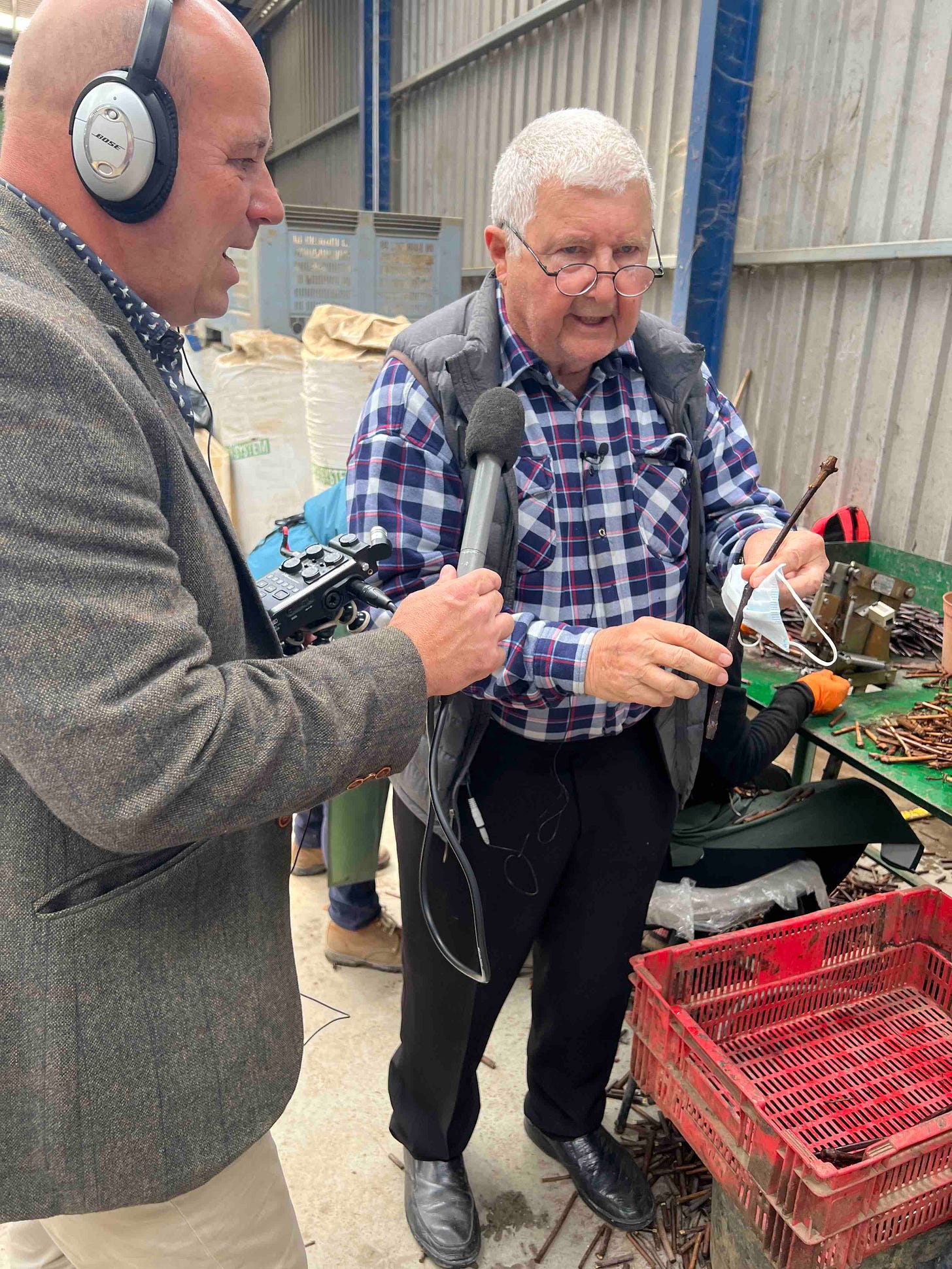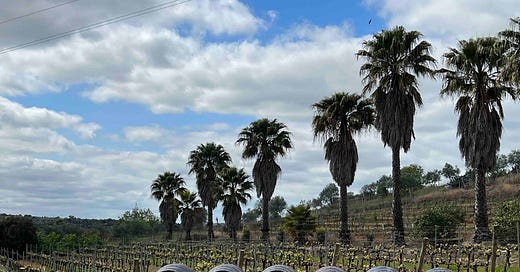A few years ago Ana and I inserted Wine into our Big Portuguese Adventure with a plan to plant a third of a hectare of grapes on our land near the coast of southwest Portugal.
Our research into the wines of our new Alentejo home has been more about the fascinating history of our region and its grapes, its storyteller winemakers and trying new tastes, than about learning the specifics of actually producing something.
But vines take time to grow and you can’t plant them all year round, so sooner or later we’ll need to know a lot more about farming, about which grapes are the right grapes, and about our soil.

So visiting the Quinta da Plansel winery and plant nursery was more than just hearing how a shipwrecked German wine heir accidentally changed Portuguese wines from the roots up, and how his daughter Dorina Lindemann began her winemaking journey with a fizz.
We went to the estate in Montemor-o-Novo to learn about vinhos and vinhas – grapes and vines – the varieties, the grafts and the pesky pests that ruined Europe’s vineyards for half a century.

Our education began in a bustling barn littered with bundles of long vine sticks and a line of workers sitting at tables with giant stapling machines.
The sound of stamping provided the background beat as fork lifts buzzed in and out, and the grafters built large piles of “little Frankensteins” as Hans Jorge Böhm called them.
Now in his 80s, Jorge explained how two types of vines were being grafted together by hand as half-metre lengths of American roots were being cut and interlocked with small clippings of Portuguese grape varieties using something called an “omega cut.”

It’s how almost all European grapes survive the destructive phylloxera pest that arrived from America in the second half of the nineteenth century and still bugs vineyards today.
“It was phylloxera, it was oidium and mildew. These diseases destroyed the European wine culture for half a century,” said Jorge, who has dedicated his life to Portuguese grapes after washing up in Lisbon in 1961 when a damaged sailing boat nipped his voyage to the Seychelles in the bud.
Wine was in his blood as heir to a centuries old German “Hock” family which was shipping millions of bottles to the US and UK.
But while exporting Portuguese wine home, Jorge realised how unpredictable its quality could be, and when the family business took a downturn in the 1970s he decided to help do something about it.

“Portugal has officially 340 different varieties in the national catalogue of grapevine varieties, but there are very few – about 80 or 90 which are really studied,” Jorge said.
He knows because he moved here to study and help develop them.
“The process of grape vine production is a technology which has been developed since the beginning of the last century.”
American root stocks were resistant to the phylloxera, oidium and mildew which invaded unprotected European vineyards when they arrived aboard ship.
Grafting the old, traditional varieties on to the resistant roots allowed wineries to rebuild, recover and thrive, but the pests remain and the process continues today.
Once grafted, wax is used to protect the join and the little Frankensteins are packed into boxes with peat and substrate to be locked away in a warming room for two or three weeks to grow together.

They are then planted in the ground for a while before being uprooted, pruned and sold to winemakers – and wannabes like us – in Portugal and all over the world.
The nursery began 40 years ago with a an in-depth study of Portuguese grapes and now produces one and a half million planting vines a year.
Back in the late 1970s, Jorge worked with the Portuguese government and winemaking universities of Évora in Alentejo and Geisenheim in Germany to select the top 40 most promising grapes, made a load of wine and took it on a global tasting road trip.
“We went to France to Montpellier University, to the Masters of Wine in London, to the university of Geisenheim and even to America to make a ranking of which are the best in the world and by this knowledge we started our breeding programme,” he said.
“The result was always the same: the Touriga Nacional was normally the best and we started to build up these varieties in different forms.”
He wrote a thick reference book on their work and began to select the best clones to make the best wines.
“In 1980 my daddy brought 150 native varieties down to the Alentejo to be planted here. We tested them for quality, quantity, performance and everything,” said Dorina Lindemann, Jorge’s daughter who moved here in 1993 after studying oenology in Germany.
She was dedicated to following the increasing international trend towards using single grape varieties for her wines.
“I started with monovarietal wines, but nobody wanted to taste my wines because everybody in Portugal was used to the blends – they had at least a five, six or seven grape varieties mixture. It changed, but the beginning was very hard for me.”
Dorina Lindemann still produces single variety wines, fresh sparkling wines and powerful blends from Quinta da Plansel.

Her two daughters are following her into the business and her father still wanders remote vineyards in the summer heat looking for new clones.
“He goes every day to the field: he goes to Spain, to the borders, he looks for which Aragonez [grape] has got more resistant, thicker skins,” said Dorina.
Bordeaux has recently allowed the planting of Touriga Nacional grapes for use in their famous and famously regulated blends – and that’s because they thrive in the searing temperatures of the Alentejo and the climate is changing.
“We did never overcome the problem of what happened in 1850, when the English imported plants from America and brought the diseases,” said Jorge.
“We reacted not by finding a variety which was resistant, but by using an excess of chemical intervention. And chemical intervention is not the solution.

“It is destroying the bees and a thousand other things, and this cannot be a solution. It was a solution for 100 years, but it's not the future.
“And that's why I'm working on that – I think this is important to maintain a natural, growing culture,” he said about his continuing, lifelong vocation of finding the perfect grapes.
And now we get the chance to try something like that from scratch – and hopefully the most suitable varieties of his freshly grafted vines for our land.
The first thing we did was turn an overgrown eucalyptus plantation into a field and a lot of firewood – some which still keeps us warm and our water hot, but the bulk of which was traded for the costs of chopping it down.
Now every day our building site takes another small step towards becoming the little tourist destination which we hope will soon be at the heart of a successful career change.

And every day I wonder which of two possible plots is the right one for whatever grapes we decide to plant.
“Logistics” a friend told us: plant on the flat where it’s easier to access to prune, water and harvest, rather than on the rocky, unterraced and steeply sloping hillside.
“Grapes don’t like wet feet,” said another, as our clay-bedded hilltop is proving to be a daily pain for the builders working in a waterlogged site after every rain.
“Use a ripper to cut through the clay,” came the response – in line with where the new vines will go and to give the plants a chance to lay down deep roots.
There may be water in the winter, but there’s precious little in the summer, so maybe that’s the right call, but I really don’t know.
Both will require a lot of work and investment to provide something for the decades ahead, so it’s not a decision we’ll take lightly.
We’re continuing to ask for advice and opinions, do some tests and take some chances, but for now the research continues...please let us know if you’d like to join the conversation.
Next time we’ll be staying with Quinta de Plansel to learn about three amazing Portuguese grapes: Touriga Nacional, Arinto and Trincadeira




I am enjoying following your exploits but am intensely interested in your vineyard project. I have Plansel on my agenda now when I visit in April. Per Richard's comment, I would wait a year and do the necessary research to match the right varieties to the right sites and map out your vineyard to reduce future problems. Re-planting will be time consuming and expensive. Best to your in all your amazing endeavors!
Thank you very much for writing about Jorge and Plansel. I went there with an Austrian group back in the 90’s and Jorge was a great source of entertainment. He has done so much for Portuguese winemaking and very few people know about his efforts. We went to visit him a couple of years ago but he was taking a nap.
Good luck with your vineyard. Plant now or wait a year!
Richard Hewitt
A Cottage in Portugal